Battling the Elements
Church Roof Repairs in the West of Scotland
Rebecca Cadie
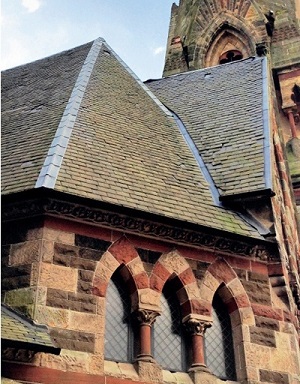 |
|
| Storm damage to the roof of Trinity Church in Irvine, North Ayrshire due to poor slate fixings and the use of lightweight zinc ridges (All photos: Rebecca Cadie) |
With the help of grants from the Listed Places of Worship Roof Repair Fund, the Heritage Lottery Fund and the VAT recovery scheme, the last few years have been extremely busy with roof repairs to a good number of churches in rural and coastal locations for us in the west of Scotland.
Weather conditions for the Inverclyde and Ayrshire coasts of the River Clyde, Argyll and the Western Isles have a reputation for being a challenge, with high rainfall combined with prevailing south-westerly winds often resulting in prolonged periods of driving rain. It has been well reported that there has been as much as a 50 per cent increase in annual precipitation in the last 50 years and an increased frequency of gales and storms as a result of climate change.
Many of the churches are now 150 to 200 years old and are reaching a stage of decay where roofing materials can no longer cope with the persistent wet climate. For these churches, regular maintenance and patching up repairs are no longer enough; comprehensive conservation work and re-roofing is often the only option.
Much of ARPL Architects’ work is involved with Scottish Episcopal churches, which often have simple Victorian Gothic style steeply pitched slate roofs on timber sarking boards and trussed or tied rafter roofs that are exposed to the interior. Other typical features include raised gables with skews (gable parapets) and a bell-cote or tower intersecting with the main roof.
Many of these churches are located on the seafront or a raised hillside and have been experiencing some extreme winter storms, which are becoming noticeably more frequent. These storms lift and disturb slates, pull up lead flashings, and in a few situations have broken and blown off stone finials. In some recent cases, bell-cotes or pinnacles struck by lightning have even fallen to the ground or through a roof.
In addition to the sudden and catastrophic damage caused by storms, a constant and challenging condition is dealing with the consequences of increased rainfall, with water penetration through stonework and the strain on capacity of rainwater disposal systems.
While the conditions in the west of Scotland may be among the most severe in Britain, the solutions and techniques developed here will be of interest to churches throughout the UK now experiencing more frequent extreme weather events.
As with all conservation work, the starting point for church roof repairs is a thorough survey, noting historic and traditional details, and developing an understanding of any weak points in the envelope and its system of rainwater disposal. When assessing the extent of repairs required, regular issues are often found that need not just repair, but more robust details and solutions to withstand the changing weather conditions. These have to be carefully detailed using traditional materials to be sympathetic with historic fabric and to ensure long life expectancy.
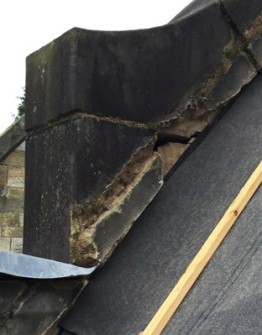 |
|
| Erosion of skew masonry beneath defective flashings, with flush cope stones above | |
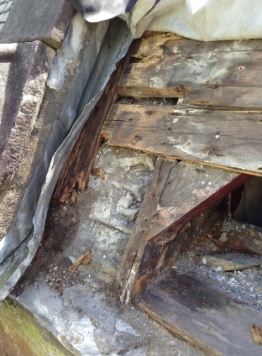 |
|
| Rotten sarking caused by a failing skew abutment | |
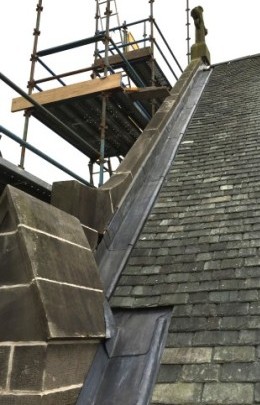 |
|
| A new ‘watergate’ with a lead skew flashing and a storm roll to prevent storm water spreading into the sarking |
Here the practical advice and design details provided by the Lead Sheet Association are invaluable, as is the advice given on a rolling programme by Historic Environment Scotland. The latter’s recent publication Short Guide 11 Climate Change Adaptation for Traditional Buildings sets out the correct approach to take when looking for a more robust defence against severe weather.
LIGHTNING PROTECTION
It is surprising to find that many of the churches do not have lightning conductors, and a specialist assessment for a protection system is now a routine ‘improvement’ to be considered. Lightning has become more frequent in the west of Scotland due to the warmer and wetter conditions.
The location and route of the conductor cables can be discreetly positioned, tucked into buttress internal corners, run along the blind side of a ridge or inside skews and then down to ground terminals located appropriately away from any graves in the church grounds.
FLASHINGS AND MORTAR FILLETS
Major problems often occur on the gable walls where the up-stand skews are highly exposed to wind and driven rain. The copes that perform best have a projecting drip, but many are eroded or were designed without the drip. Wind-driven rain can also penetrate the mortar bedding joints and this may be improved by re-bedding the cope stones on to a lead damp-proof course and securely fixing them through the lead to the wall-head.
Skew abutment flashings in particular have been failing under the weather conditions with water penetration causing damage to church interiors. Aged leadwork which has had to be dressed back repeatedly following storms becomes malleable and brittle with cracks developing, making it more vulnerable to wind-lift.
On removing slates and skew flashings it is common to find that the sarking boards abutting the skew are rotten, with a strip of decay up to one metre wide. When water penetration has been prolonged, the first rafter may also be rotten if it is touching or close to the skew stonework. Replacement sarking should be formed with treated softwood timber boards of the same thickness as the original and preferably butt-jointed. Ply sheet is not a suitable substitute because it does not allow the same level of air flow across the roof and it is difficult to nail slates to it securely.
If stonework remains saturated following prolonged periods of rain, damp is likely to spread, penetrating the core of the walls and damaging interior plaster. A traditional detail found where skew copes have shallow up-stands is a mortar ‘parging’ fillet, which can be badly affected by cycles of saturation and wind-drying that produce cracking. If it is not possible to replace the fillet with a lead flashing, a more robust alternative is to form a new fillet over a stainless steel mesh that is wedged into the skew bed.
Erosion of stone underneath lead flashings can occur when the stone has been under saturation conditions and indents are often required to ensure a sound base for new leadwork. The risk of saturation may be reduced by increasing the roof-cover width of the leadwork to form a ‘watergate’ (a lead-lined channel) with the upstand on one side and a lead roll to the slate edge on the other. This detail can greatly improve the safe disposal of water and reduce seepage and leaks into the sarking.
An increase to the up-stand of the lead flashing and deeper cover flashing depth may be considered if there has been stone repair, but it may be more appropriate to dress back into the original chase to avoid weakening or damaging the skew stonework. Traditionally, the leadwork would be pointed in with a lime mortar. However, with increased rain and wind action and more thermal movement of the lead, it can be more effective for long term performance to use a lead plumber’s mastic sealant to the top of the cover flashing.
Where water penetration through skews has become extensive, further protection can be provided by cloaking the copes with a lead capping, either by tucking the lead into a groove or ‘raggle’ cut into the top surface of the cope, or entirely capping the cope.
This not only changes the appearance quite dramatically (in some cases requiring formal planning and listed building consents), but it also changes the way a cope behaves, with an increase in fast water run-off from its smoother surface. As this may affect the wall below, careful consideration should be given to whether a full covering is really necessary.
The replacement of lead flashings and dressings that have aged or are storm-damaged provides an opportunity for more robust detailing. Increasing the code of the lead flashings improves their resistance to wind-lift and enables the girth and cover of flashings to be extended. At valleys and parapet gutters the lap may be extended under the slates and the depths of the stepped joints may be increased, while catch pits or ‘sumps’ can be added at outlets to increase the capacity of the gutter. Combining these improvements with larger chutes and outlets to hoppers enables the disposal system to handle a greater volume of rainwater.
ROOFING SLATES
Slates disturbed by high winds often rattle on their fixings, which wears away the fixing holes and then loosens them, making them more prone to slippage. The choice of nails and fixing methods can make a significant difference to whether a roof can withstand extreme weather.
The importance of the diminishing courses typical of traditional roofs has often been under-appreciated, but the smaller slates at the higher parts of the roof are less likely to be flipped up by the wind due to their greater weight relative to size, while the lower, larger slates are better for coping with a larger shedding of water. New slates that are uniformly sized and larger than the typical small traditional ones, will not perform well when on an exposed roof, even if they are of good quality.
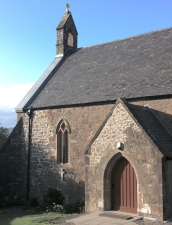 |
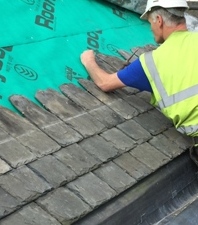 |
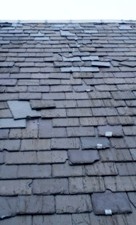 |
||
| Above left: a reslated roof with lead caps to the skews. Centre: a roofer cheek nailing slates on an exposed roof. Right: a wind-damaged slate roof with tingles and a variety of other poor repairs | ||||
The typical specification for Scottish slating is to ensure a good deep lap of slate coursing, and the outer two metre edge of a roof is often fixed more securely by double nailing or cheek nailing (a nail at the head and another at the side of each slate). We have seen a remarkable range of refixing methods using ‘tingles’ (clips) and adhesives, but have found the same roof will remain sound in storm conditions if properly re-slated with traditional detailing and following best practice.
The selection of replacement slate is important. It is often possible to salvage up to 50 per cent of the slate from an existing roof for reuse on the most appropriate roof planes. Ideally, these would be supplemented with new material to match, so it is a disappointment that there are no longer slate quarries open in Scotland on a commercial basis, and the stock of salvaged slate is constantly diminishing. Nevertheless, it is usually possible to find slates which match those originally used in the area and which perform well in the climate, being of similar weight and density and resistance to frost. For best weathering and aesthetic results, either second-hand scotch slate can be specified for a historically sensitive roof repair, or Welsh or Cumbrian slates of assorted sizes for re-roofing.
For the higher roofs found on churches it is important that ridges are also robust enough to withstand the increased severity of weather. These can often be stone ridge pieces or clay ridge tiles and checking integrity and bedding is important to ensure they continue to perform well. The zinc ridge flashings and clips often used on lower roofs and houses are prone to storm damage when used in a highly exposed location, and the use of traditional lead roll ridges reduces the problems. If constructed using lead of code 8 or 9, these should be heavy enough to withstand intense storms and can incorporate a discreet ventilation detail which helps keep the roof timbers healthy.
GUTTERS AND DOWNPIPES
A particular detail of older churches with a classical Georgian design is a leadlined channel on a parapet. This detail is routinely found to be a problem as the capacity of the channel is incapable of handling the quantity of water now experienced and the stonework is often badly eroded. Capacity may be increased by indenting the channel or by fixing a timber section to the outer edge to increase depth, which can then be dressed in lead. Forming steps in the lead lining of these channel gutters is usually not possible and the use of neoprene gasket jointing strips (such as T-Pren) may be necessary.
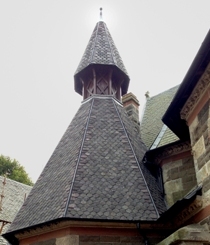 |
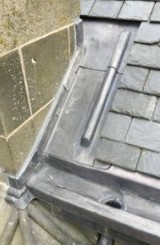 |
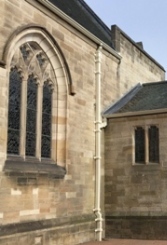 |
||
| Above left: new Welsh slate work on the vestry spire of Trinity, Irvine with code 6 lead roll hip ridges. Centre: a relined channel gutter with a new watergate detail above. Right: rainwater goods replaced with larger cast iron sections and a wide watergate to cope with increased rainwater. | ||||
Where eaves gutters are used the majority are cast iron. The material is unrivalled for durability and strength, and if well maintained can last in excess of 80 years. Many traditional patterns that match original fittings are still manufactured, and these would always be a first choice when replacing badly corroded pieces. In some situations, cast aluminium sections with traditional profiles may be used for cost savings and for easier handling of longer sections.
The whole rainwater disposal system needs to be regularly checked for blockages and vegetation build-up as overflowing gutters and downpipes can cause considerable damage to the walls and the interior. The run of gutter levels should be checked and joints re-sealed before decorating. When full replacement of a cast iron system is required, it is practical to increase the capacity with larger half round gutters or deeper ogee sections, and with larger or more frequent downpipes. Eaves cornice gutters that sit on a stone eaves corbel can incorporate a lead ‘safe’ flashing which is visually discreet and is tucked up under lower slates to prevent flash-flood overflow into the building.
Some changes to the way roofs are detailed may be necessary to ensure the survival of the fabric below, but they should only be undertaken once the original details have been properly recorded and understood. Often these evolved out of the need to provide the most effective use of locally available materials, and ignoring their significance leads to the erosion of character and regional distinctiveness. In some cases, the result is also a roof that does not work.



